| |
Issue 12 : March 2013 |
| It was encouraging to start the year with a response, rather delayed admittedly, to an article we published about Cabotage. Some in Hawaii, Puerto Rico and other non-contiguous US states, territories or dependencies commenting on the downside to them of the Jones Act. Their comments also highlighted how very difficult it will be to change anything despite the enormous economic benefits that would ensue. Too many vested interests or not enough political benefit! In this newsletter we thought a touch of luxury would chase the cold night away in Europe and the US, I would have a grumble at people ignoring Indonesia except that the worm seems to be turning, then a little bit of a look at the container sector afloat and ashore. Carolyn has also added an article adding value to your training budgets! As always, it will be good to get your feedback on our opinions and comments in this newsletter, just contact me on [email protected] |
 |
|
Sleeping Giants the Absence of Indonesia from the World Stage
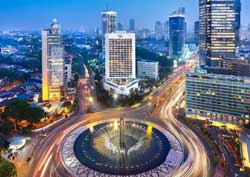 |
|
A few months ago I chaired a conference in Hong Kong. One of the speakers set out some scenarios for the future. The continued growth of China, the rise of India, European decline a renaissance across Africa all featured. Something that did not feature was any comment, not even a small footnote, about perhaps the most robust economy over the last few years of crisis, Indonesia, the world’s 4th largest country by population; the world’s largest Islamic nation. How could that be? How in a room with plenty of Indonesian in it could that |
be allowed to pass unchallenged? Yet, unchallenged it went, until I raised it myself. When raised the answers did little to improve the perception that the European responsible simply did not see the point of bothering with Indonesia. Talking with friends and prospective clients a different perspective (more of those later) emerged.
Political policy and the personal choices of individuals are very different but the relationships between them does echo through history. Perhaps Indonesian’s are like the Britons of the late 19th Century, or the Americans of the 1930s? Briton’s Splendid Isolation, a policy that kept Briton from interfering in continental Europe for close on a century after Waterloo and at the very least contributed to the conception of two “world” wars that devastated Europe. Isolationism in the US, a feeling that they were far from Europe and European arguments were not relevant to America; those Europeans being after all nothing but trouble; a policy which begat more trouble and ended in more change in the US than any other foreign policy in the country’s history.
So to Indonesia, a strong self belief, a belief that Indonesia does not need advice or support, attitudes that translates into a general absence from the world stage. Is this harmful or helpful? For the rest of South East Asia it could signal disaster; Indonesia in many ways is South East Asia. Without Indonesia their representations and positions are of far more limited consequence in the world. In Indonesia learning and applying lessons from the mistakes of others must surely be helpful. Accelerating growth and targeting policy moves that can empirically be shown to work in similar circumstances should allow the lives of millions to be improved. It should be a winning ticket in any election.
As a kicker to the above, which was written a few weeks ago, the level of interest in Indonesia from investors has gone through a fundamental change in recent months. It seems to be the last best hope for growth. The numbers of enquiries has literally gone through the roof, investors are trying to put boots on the ground and identify and secure the low hanging fruits for quick deals and gain market penetration in an aggressive way that has surprised and at times concerned me. The reason for the concern is and what has not surprised me is that many of them have no cultural understanding of Indonesia and I think the Indonesians, in the nicest possible way, are “going to have them for breakfast”. Nathan Rothschild and Churchill Mining are highly professional and they may have a similar view to mine! The most intelligent of the rushing hoards of investors are heading to get the help of those who have survived and prospered in Indonesia over many years. For the sake of Indonesia I hope the next few years goes well.
Adding Value to the Training Budget
| In January the Economist reviewed a new book that challenges the received wisdom about what ensures success in life from education. “How Children Succeed” by Paul Tough is a refreshing and insightful read though perhaps it should be entitled “How to Ensure Adults Succeed”. The book uses long term studies to illustrate how character traits such as persistence, curiosity, optimism and self-control are much more reliable predictors of success in adult life (stable, productive work and family) than IQ. |
|
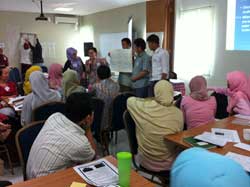 |
In my last news item I argued that learning is an essential component in a developing a thinking, innovative and an effective company. Paul Tough demonstrates a firm grasp of the concept that the best learning is promoted by positive attitudes to learning and the development of character. So, what are the implications of this for companies and organisations?
It is obvious that simply providing opportunities for employees to learn is not a guarantee that effective learning will take place. At a recent conference I was unfortunate enough to be sitting in front of another participant who consistently snored his way through presentation after presentation. I was also intrigued by the number of people who can attend a conference and did not have any questions for the presenters. If we assume that presenters mostly have an important message and additional experience that can widen our perspectives, how can participants be encouraged to be more engaged in learning? There is no simple answer because changing attitudes can be a slow process, but here are a few practical suggestions how you may be able to get more value out of your training and development budget:
- Value learning by defining it, what is the aim of that conference or course?
- Ensure your staff learn about how our brains really work; it is all about connections
- Make sure staff are aware of different learning styles including their own
- Inspire everyone to see the benefits of learning and have the right approach to it
- Ensure everyone shares their learning, particularly after courses and conferences
- Understand that one of the best ways to consolidate learning is to teach others!
Luxury Market Knowledge
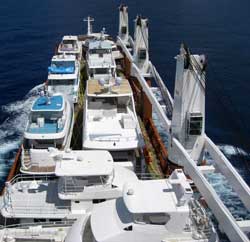 |
|
In recent weeks we have been working in the luxury goods sector; how to ship a yacht, Aston Martins, art collections etc... It has been something of a revelation. The detail and approach to assessing with whom and how to ship in this sector is radically different from much of the rest of port and shipping business. Never before have I been asked in a market study to provide a photograph and biography of the key people who may be involved at each port. Further, to discover the likes and dislikes of each one, the approach they take to management; effectively profiling each decision makers’ style and approach to life. Then after this introductory review finding our client needed a similar level of detail on: security providers, customs, immigration, logistics |
operators and warehousing. Whilst initially less than impressed or confident in the approach our client wanted to take I have to admit it certainly helped me gain insight into alternative approaches to procurement and ensuring the effective delivery of port services. Looking forward to applying the techniques and approaches developed in other studies!
Coal Market Downturn
| The fall in the coal price has certainly had an impact on the speed and number of coal terminal developments in Indonesia. Companies have laid their off development staff. Projects have been shelved. This all seems slightly odd given the long term competitive advantages of Indonesian coal and the huge domestic power generating demand. Proximity to market, production cost (usually!) and what remains a relatively generous tax regime. Now with logistics costs falling as barge use falls the advantages swing further towards Indonesian coal. |
|
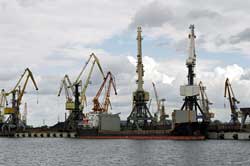 |
Surely now is the time to sort out some of the key infrastructure issues because, to be frank, the less visionary and too scared are not able to take advantage of the opportunity available in this coal down turn. So long term investors step forward to deal with the Musi River transport system, seize the opportunity for coal hubs near the Burrito and Mahakam rivers and other opportunities in Kalimantan and Sumatra. The next few years represent the window in which Indonesian coal infrastructure needs to be reformed and four or five key 100 million tonnes per year coal terminals have to start to emerge. The environmental and economic consequences of incredible volumes of transshipment at sea have to be addressed. It was heartening to meet an investment fund who completely independently of me and with a level of thoroughness for a newcomer I had to admire had reached the same conclusions: key coal hubs were essential and the transhipment strategies a dead end for Indonesia despite the simple commercial position they take which provides a short term problem and risk to any coal terminal developer. Hard selling a premium long term product when the barrow boy is selling quick money with no requirement to think and put in the hard regulatory yards.
Systemic Risk to Container Shipping
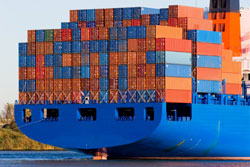 |
|
Is container shipping a “dog” or a “cash cow”? I was recently doing some work using the Boston Matrix and got to thinking about where to place the container shipping sector. In my view no company in the sector can be said to have a strong or high market share; except in some specific niche markets. Up to 2008 container shipping was a high growth market placing companies in the question mark category. Since 2008 container shipping I would contend should be seen as a moderate to low growth market, moving all those |
companies to be varieties of “dogs”. But it does provide some form of explanation of the strategies of some shipping companies. Pre-2008 if you could get to an appropriate market share your question mark should in theory become a star… This thought pattern fed into my views as a long term critic of investments in large container ships and shipping in general, entertaining it was soon after that I read that AP Moeller Maersk were no longer focusing their investment on the shipping line. Are they moving toward the critical analysis and views expressed above?
Think about the health of the industry if many of those large ships had not been purchased in the last three to five years. Would rates charged be any different? If anything they would be higher. Profitability of shipping lines would probably be rather more comforting to investors and the cash positions and cash flows of the shipping lines would be rather different from their current reality.
Recent commentary on the failure of rate restorations (in English that means increases) combined with the financial position of many carriers has left me pondering two points (i) how long until the competition authorities take a hard and critical look at “capacity management” to try and increase rates (ii) what is the systemic risk to the industry, is it possible for the sector to collapse under the weight of its debts and negative cash flow?
What happens if the container shipping industry does collapse? Is it a vital utility ensuring economic activity is maintained, even further that people eat and drink as they desire? If the industry was banking systemic risk would it, in the light of 2008, be a key concern of the politicians. Is the container shipping sector in a similar position? How close are we to such systemic risk or is the balkanization of the sector an effective protection against systemic failure.
Container Terminal Capacity and Productivity
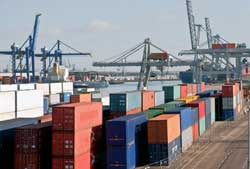 |
|
How many containers can a terminal handle? What is good productivity within a terminal? Is it possible to benchmark between terminals? These are important questions for banks, investors and port authorities amongst others. However a quick review of some gross measures of productivity make it very clear that gross productivity figures can vary by factors of 2 or 3 even when the market is saying those terminals are effective and well managed. Either there is an alarming difference in productivity between terminals, operators and |
regions or container terminal productivity is not easily benchmarked. Hopefully most involved in the sector would appreciate some of the degrees of freedom within any assessment of container terminal productivity include:
- Type of handling equipment in the storage yard (RMG, straddle, reach stacker etc…)
- The ships calling at the terminal (ship size, exchange volume, route structure)
- The container traffic (transhipment or origin & destination; import/export balance)
- The nature of the containers (full or empty)
- Hinterland transport impacts (dwell times, road/rail/barge evacuation/delivery balance)
So how to achieve and realistic appreciation of the relative performance of terminals and terminal operators? This can only be achieved by more detailed understanding of the market, logistics chain position, country specific factors and I could go on for longer. In terms of capacity and productivity think of a container terminal like an elastic band and one that can stretch a surprising long way give the right management and manipulation of external factors. This discussion becomes a financial risk when contracts start to use “capacity” within their terms as if this was a fixed number. Give me those contracts and we fight over the final meaning for years.
|